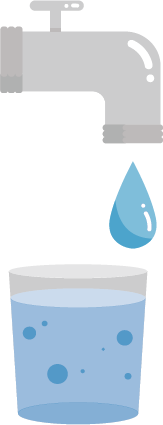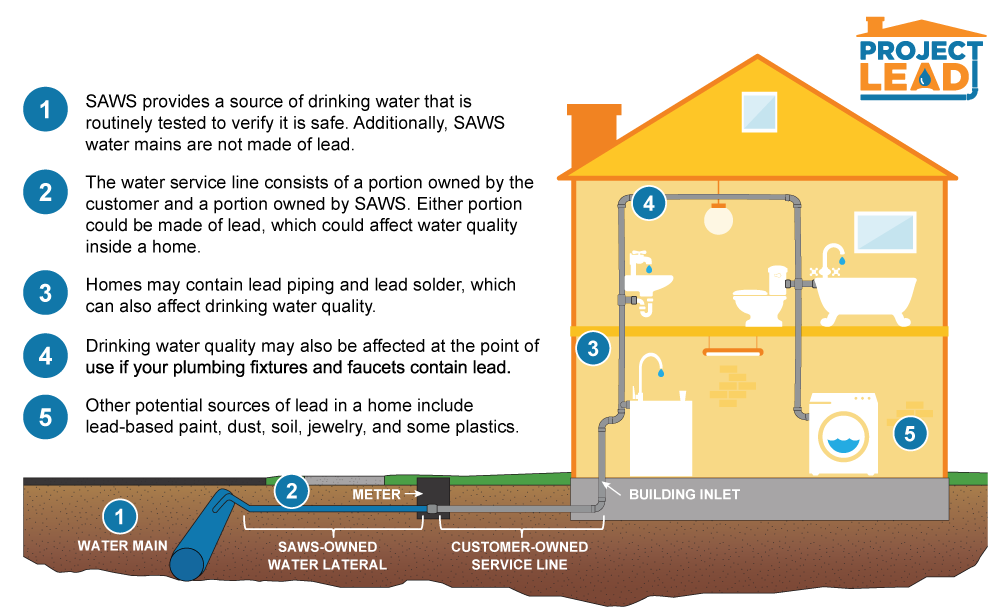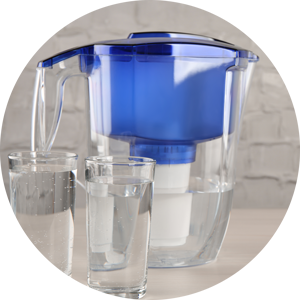 Why Check For Lead?
Why Check For Lead?
San Antonio Water System is working to identify customer-owned water service lines that contain lead material. We are doing this as part of a new program required by the U.S. Environmental Protection Agency (EPA).
This fact sheet will help you identify potential sources of lead in your home. You’ll also learn how lead can affect your health and, most importantly, how to reduce lead exposure for you and your family and friends.

Exposure to Lead Can Affect Your Health
Exposure to lead can cause serious health issues in all age groups. Infants and children are of special concern since high lead exposure can affect IQ and attention span. Potential impacts can include:
- Learning and behavior problems — lead exposure may also worsen existing issues.
- Children of women exposed to lead before or during pregnancy can have increased risk.
- Adults can have increased risk of heart disease, high blood pressure, kidney disease and/or nervous system problems.
Potential Sources of Lead
Lead is a naturally occurring material that was used for many years in residential and industrial plumbing products. Historically, lead was considered a good material for plumbing because it could easily form into different shapes and resist leaks.
For this reason, older homes may have lead-containing service lines, plumbing, and kitchen or bath fixtures. Lead may also be found in paint and other products, especially in older homes.
Please visit the San Antonio Metropolitan Health District website at sanantonio.gov/health for more information.
Lead exposure can occur from multiple sources within a home.
Additional information about your drinking water system and potential sources of lead are included below.


Simple Tips to Reduce Lead Exposure in Your Home
- Test your water if you are concerned about lead in your drinking water. Tests should be performed by a state certified laboratory.
- Flush your tap for at least 5 minutes before drinking or cooking if the water in the faucet has gone unused for more than 6 hours (for example, first thing in the morning).
- Filter your water. Use a water filter that is NSF 53 certified for lead removal. Many filters and filter systems can improve water quality and taste in other ways too. Visit nsf.org for more information.
- Use cold tap water for drinking and preparing food. Hot water is more likely to contain lead than cold water.
- Clean faucet aerators and flush cold water taps regularly. Aerators can collect particles from lead plumbing and should be removed and cleaned on a regular basis. It is especially important after household plumbing work and repairs. After removing the aerator, flush the cold water lines for 5 minutes.
For More Information
SAWS works hard to provide a safe source of drinking water to our customers. Because property owners within the SAWS service area own their water service lines, there is a shared responsibility to manage potential lead exposure. We are ready to work with you to answer your questions about water quality and Project Lead.
SAWS website
Information and helpful tips on lead in drinking water:
saws.org/lead
San Antonio Metropolitan Health District
Information on health impacts and childhood blood lead level testing:
sanantonio.gov/health
Texas Commission on Environmental Quality
Drinking Water Lead and Copper Program:
tceq.texas.gov/drinkingwater/chemicals/lead_copper
United States Environmental Protection Agency
Resources to understand and reduce lead exposure: epa.gov/lead
National Lead Hotline: 1-800-424-LEAD (5323)
About Lead Joints and Connectors
Our water service line was inspected and found to be of a non-lead material, but there is a small lead joint or connector that was identified. What do I need to do next?
Current regulations do not require any further action by SAWS to remove lead joints or connectors from customer-owned water service lines. However, if a lead joint or connector was identified on the customer-owned portion of the water service line, it is important to know:
- Most connectors are made of a combination of metals that may include a percentage of lead.
- As part of SAWS ConnectH2O, our electronic meter program, all connectors will be replaced over the next few years.
If you are still concerned about the presence of lead in a connector, you may, at your own cost:
- Purchase and use a certified pitcher filter for water used for drinking or cooking.
- Hire a licensed plumber to get the joint or connector replaced. Once you do that make sure to submit the information about the replaced lead joint or connector to SAWS at lead@saws.org so that the publicly available inventory will reflect the correct information for your address.
- Use a local lab to test a water sample collected from inside your home. SA Testing is one option.
